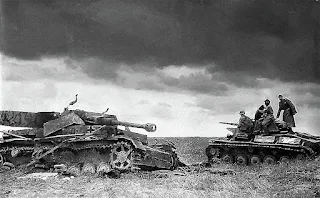For reasons I no longer remember, I was interested in the ratio of commissioned officers-to-non-commissioned soldiers in the Soviet Army.
My duck-duck-go skills were not up to the task but I did learn that during WWII there was one Soviet commissioned officer fatality for every eight non-commissioned fatalities.
That seemed astronomically high. The current US infantry tables-of-organization defaults to 3 "heavy lifting" squads of nine each, a weapons squad and a communication squad. Let's say that is 35 enlisted. That infantry unit has a Lieutenant in command and the rest of the org-chart above that is very flat.
So, in round numbers, let me speculate that the ratio of commissioned officers-to-enlisted at the boots-on-the-ground, operational level is 1-to-25.
That makes the KIA ratio of 1:8 puzzling.
Zampolit or Political Officers
Stalin was paranoid. He assigned every officer their own, personal political officer to ensure ideological purity and to ensure the army was not plotting to over-throw him.
That would drive the ratio from 1-to-25 to about 1-to-12. Still a long way from 1-to-8 especially since officers tend to value the comforts and safety of rear-echelon areas.
In point of fact, Stalin was so paranoid that military officers were prohibited from entering Moscow. Sneaking into Moscow or any of the other large cities for some R&R was likely to get you summarily shot. As an officer, it was actually safer at the front than to be skulking around Moscow.
Another factor that contributed to the estimated one-million Soviet commissioned officers KIA in WWII is they were killed off so quickly that every officer was the operating way above their pay-grade and level of training. It was the Peter Principle driven by necessity.
New lieutenants, not knowing any better, would position mortar squads in full view of the enemy or stage troops on-the-flat within range of the enemy's 88mm artillery. The incompetence was pervasive, from Corporal to General. Troops were moved without accommodations for logistics. Medical care near the battlefield was almost non-existent, tactical and strategic opportunities were not exploited and so on.
The life-expectancy of a Second Lieutenant on the battlefield has always been short. One historian estimated that the median in-theater life-expectancy for a US 2nd Lieutenant in WWII was 88 days. Another historian figured that the average life-expectancy of a 2nd Lieutenant in the middle of a fire-fight in Vietnam was 15 minutes.
It is easy to see why Soviet officers were mowed down in such numbers.
Bonus factoid
The US Military currently has a 1:4.9 ratio of commissioned officers-to-enlisted.
CRT trainers are the new Zampolit. I wonder if they appreciate the KIA ratio they will be exposed to if their fantasies are realized.

You have to ask if the kill ratio wasn't due to non-coms fragging their officers and political officers due to some having experience and a will to survive that was being denied because of incompetent officers. Even in our Army during the middle 70s we had to deal with incompetent officers and many of hushed discussions among troops that was discussed.
ReplyDeleteERJ, any idea if the current Chinese Army has the same issues with their political officers - or are likely to?
ReplyDeleteThe emergence of the US version of the Zampolit is not a welcome sign, and I suspect will only degrade capabilities further (as it often does, as who wants to get sideways of the Zampolit?).
My guess is that they have some variant of the Chinese Social Credit score. If they roll-up one dissident then they have a string to reel in everybody who came within 2 meters of that person.
DeleteLet me reiterate, that is just a guess.
There are actually three kinds of soldiers in an infantry company - officers, non-commissioned officers (ie - Sergeants), and private soldiers. So when you are talking about "non-commissioned soldiers", are you referring only to actual NCO's? Or do you mean ALL soldiers (the total of all NCO's plus all Private soldiers) who are not officers?
ReplyDeleteIf you are talking one officer killed per every eight NCO's killed, that does not seem shockingly high. But if you mean one officer killed per every eight NCO's + Privates killed, then yes, that seems high.
As for the possible reasons, all the ones you stated make sense. Especially Zampolits being fragged by their own troops. But also, consider that the Soviets had the unenviable position of fighting the German Wehrmacht, which was the finest and most modern mechanized army in the world at the time, with superb leadership, and very high esprit decor. Not only did that fact alone likely create greater overall casualties for the Soviets, but also proportionately greater casualties among the Officer and NCO ranks.
One commissioned officer to eight NCO + Privates.
DeleteGood catch.
Thanks
I've read that Stalin had many officers killed or imprisoned in the late 1930's due to his paranoia, so at the beginning of the war his officers were VERY green.
ReplyDeleteIt’s my understanding that the soviets didnt have a professional NCO class. Duties and authority that NCO’s in European and American armies would have were performed by lower ranked commissioned officers in soviet forces.. This would help explain the 1:8 casualty ratio.
ReplyDeleteTSgt Joe has it right. the Soviet armed forces do not and did not have the depth of NCO professionalism that we have in the US armed forces. Their leaders, at all levels of leadership, were officers.
ReplyDeleteJust wait until the Intersectional Forces replace the Special Forces because they aren't "special" enough.
ReplyDelete